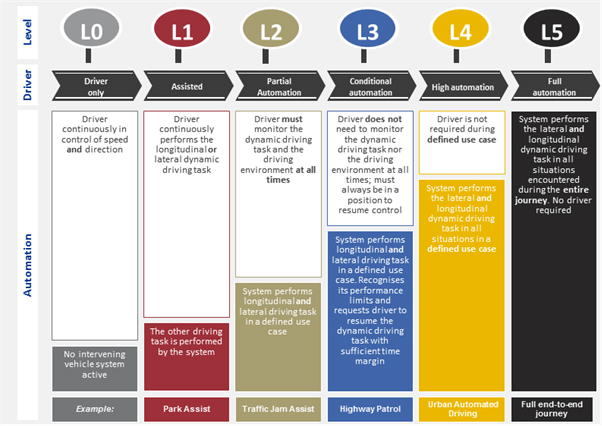-
Connected and automated vehicles (CAVs) will provide huge social, industrial and economic benefits to the UK. In particular, these innovative vehicles will expand our industrial base, improve safety and congestion, drive up productivity and free up space usually devoted to vehicles in our urban areas.
CAVs will transform the lives of six out of every 10 people in the UK, according to our research published with Strategy&, PwC’s consulting arm in Connected and Automated Vehicles: Revolutionising Mobility in Society. The first comprehensive UK-based study of the human impact of CAVs, canvassed the views of more than 3,600 respondents and found that this new technology will offer freedom to some of society’s most disadvantaged, including those with disabilities, older people and the young.
Connected vehicle technology is varied and can be grouped under the following headings:
- In-vehicle systems
- Commercial management systems
- Infrastructure systems
- Vehicle to vehicle systems (V2V)
- Vehicle to infrastructure (V2I)
There is already a staggering level of connectivity and autonomy in vehicles compared to just a decade ago – in 2015, more than half of all new cars sold in the UK featured autonomous safety features. Automated emergency braking and lane assist technologies provide safer driving and internet connectivity over mobile networks is capable of keeping vehicle occupants connected to the online world.
According to the KPMG study commissioned by SMMT, connected and autonomous vehicles are set to add £51 billion a year to the UK economy by 2030. This is in addition to creating 320,000 jobs news, 25,000 specifically in automotive manufacturing.
To find out more about connected and autonomous vehicles read our position paper.
-
Levels of autonomy (LOA)
There are six levels of automation used internationally by industry, ranging from zero to five. Level One refers to a situation where a driver has full control of the car but some driving tasks are performed by the system (for example park assist) whereas Level Five is full automation and not requiring a driver.
To find out more about connected and automated vehicles read our position paper.
-
Intelligent transport systems (ITS)
Beyond connected and autonomous vehicles, Intelligent Transport Systems is a wider cross sector area of development.
ITS allows communication not just between vehicles themselves, but also vehicles and infrastructure. Utilising these communication systems will help to reduce road accidents, relieve congestion and reduce emissions.
ITS is already in use on UK roads – for example urban and motorway traffic management and control systems, electronic toll collection and route navigation systems. Another safety technology in development is Intelligent Speed Adaptation (ISA). ISA systems inform the driver of the speed limit for the road they are travelling on, automatically reducing the speed of the vehicle if necessary.
In 2015 UK government established the Centre for Connected and Autonomous Vehicles (C-CAV), a joint policy and strategy unit. C-CAV provides a single point of contact for industry and academia for CAV technologies and will coordinate and enhance government activity in the sector.Testing of driverless cars is already taking place on British roads, with Bristol, Milton Keynes and South-East London selected as test cities. The Bristol Venturer consortium aims to investigate whether driverless cars can reduce congestion, while the GATEway scheme in Greenwich is testing automated passenger shuttles and valet parking and Milton Keynes tests its LUTZ Pathfinder Pods in pedestrianised areas.
In February 2016, £17 million of funding was awarded to eight collaborative R&D projects as well as additional funding for 14 feasibility studies. The projects will stimulate development in key areas of autonomous vehicles and connected transport systems including:
- Real-world testing of vehicle data connectivity technologies putting driverless vehicles through their paces in simulators
- Assessing design aspects for older, disabled and visually-impaired users
- Programming driverless cars to behave more like human drivers
- Studying how driverless freight vehicles can be introduced to UK roads
To find out more about connected and autonomous vehicles read our position paper.
-
Despite increasing levels of connectivity and autonomy in today’s vehicles, much needs to be done to unlock the economic, social and environmental benefits of this technology. Industry has identified four overarching challenges for connected and autonomous vehicles:
- Technology
- Policy
- Behaviour
- Business Models
To make the UK a global centre of excellence and to support the UK automotive industry SMMT set up the Connected and Autonomous Vehicles (CAV) Forum.
To find out more about connected and autonomous vehicles read our position paper.
Technology & Innovation











